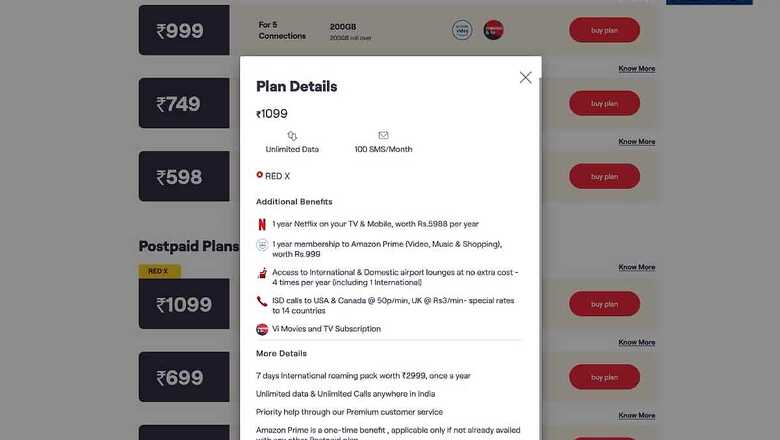
views
Even as the brouhaha continues about whether the priority 4G network access and better 4G data speeds as promised by the Vi REDX (earlier Vodafone REDX) and the Airtel Platinum bill plans is even legal or not, you might perhaps be wondering if this differential treatment on a network is even possible. Can a mobile service provider, such as Vi or Airtel, offer different 4G data usage experience on the same network, to different users? Let us take the example of two Vi users—one on a lower spec Vi RED Rs 399 plan and another who pays for the Vi REDX plan. Can they both get different 4G speeds and usage experience, on the same network (let us assume they are sitting next to each other and accessing the network from the same location) while perhaps even using the same smartphones? The answer is yes. It is very much possible. But, they may still not be able to guarantee exact speeds on a mobile network.
It all starts with Quality of Service Class Identifier, or QCI, which is how each subscriber or user on the network is tagged for the service they will receive. On a mobile network, there are different services at play at the same time—there is voice, there is data and within data, there are different types of traffic. Mobile operators will assign a QCI code to your account, usually ranging between QCI 1 and QCI 9. Voice services, for instance, are almost always assigned QCI 1. But it is the data that can be further classified and prioritized depending on user. Within the QCI scale, there are some that offer guaranteed bitrates (GBR) for the services while others are non-GBR. Voice, for instance is GBR, but your 4G data is not.
According to the official specifications for 3GPP Long Term Evolution (LTE) networks, a QCI tag is the “scalar that is used as a reference to a specific packet forwarding behaviour (e.g. packet loss rate, packet delay budget) to be provided to a SDF. This may be implemented in the access network by the QCI referencing node specific parameters that control packet forwarding treatment (e.g. scheduling weights, admission thresholds, queue management thresholds, link layer protocol configuration, etc.), that have been pre-configured by the operator at a specific node(s).”
So, how do these service classifications and levels impact the 4G data speeds and experience? There are a lot of things dependent on the QCI stamp for your account. Latency, throughput, jitter and packet loss are some of the ingredients that define the experience.
While it is not exactly clear in the public domain what QCI tags are provided by Vi for REDX users and non-REDX users or what tags Airtel offers to Platinum plan subscribers and what is the tagging for those who aren’t on a Platinum plan, there clearly can be preferential treatment for certain 4G LTE users on mobile networks. It is a global trend as well, nothing new. When Vodafone-Idea said in its submission to the Telecom Regulatory Authority of India (TRAI) that the REDX customers get at least 1.5 times better speed than other Vodafone-Idea users on the same network, it is all because of the QCI that gives preferential service to the REDX users while tapping the same common resource pool—that is, your mobile network. That is exactly the contention that TRAI has with the premium plans that promise better data speeds to certain users. The regulator wants to understand how this impacts the networks, and the other users on the network. The fear is, prioritising certain users for better speed and bandwidth, will reduce the same bandwidth that has to be shared with other prepaid and postpaid users who aren’t on premium plans. That hurts the very idea of equal access and net neutrality.
It must be noted that neither Airtel nor Vi guarantee data speeds for the premium users either, even though these plans have much higher or unlimited data bundled, but the scheduling weights can enable these users to theoretically get faster speeds on the same network, that you and I probably cannot. Also, the promise of faster 4G speeds have also been toned down by Airtel and Vi while advertising their higher-spec premium plans now. At least till the matter is resolved, one would imagine.
Vodafone had launched the RedX premium postpaid plan in November last year priced at Rs 999 per month with a host of add-ons and value adds for subscribers, including the Netflix and Amazon Prime subscriptions. The plan was listed with the TRAI at that time, though no objections were raised then. In May this year, Vodafone revised the tariff to Rs 1,099 per month and listed the plan again with TRAI as per the required guidelines. It was in July when TRAI raised objections on premium postpaid plans from Airtel and Vi. Vi’s other postpaid plans are priced Rs 399 onwards and do not offer any preferential 4G network access. Airtel’s postpaid plans start at Rs 499 with the options of the Rs 749, Rs 999 and Rs 1,599 postpaid plans. It was in July when Airtel CEO Gopal Vittal, in an email to all subscribers, said that Platinum users “now have access to Preferential 4G Network, which translates into higher data speeds.”

















Comments
0 comment